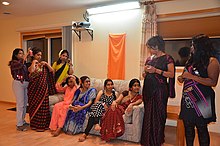Kitty party
[2][3] Initially, the informal savings events were hosted at home by middle-class women in northern Indian states, such as Punjab or Uttar Pradesh, whose families were struggling to recover financially from the turmoil caused by partition.
[2] Alongside the financial aspect, kitty parties also created a valuable social outlet for women, many of whom were not culturally permitted to work or travel much outside the home.
[3][4] By the 1980s, the growth of consumerism in Indian society meant that kitty parties had evolved and were also becoming popular with wealthier women, who used it as a way to save for more expensive household items.
At meetings, members may share personal stories, business tips, family recipes, or general "skills and hacks.
"[3] Entertainment can include guest speakers, cooking demonstrations, themed costume parties, parlour games, tarot card readings, and more.
